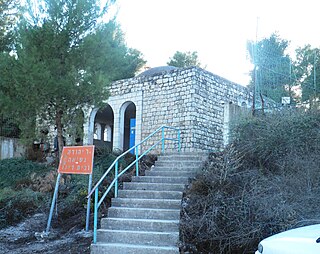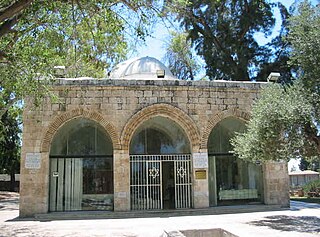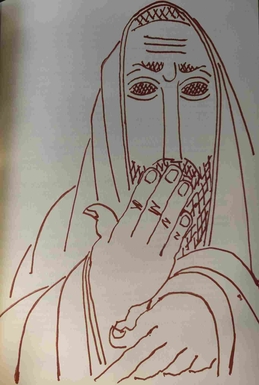Related Research Articles

Judah ha-Nasi or Judah I, was a second-century rabbi and chief redactor and editor of the Mishnah. He lived from approximately 135 to 217 CE. He was a key leader of the Jewish community during the Roman occupation of Judea.
Amoraim refers to Jewish scholars of the period from about 200 to 500 CE, who "said" or "told over" the teachings of the Oral Torah. They were primarily located in Babylonia and Ancient Palestine. Their legal discussions and debates were eventually codified in the Gemara. The Amoraim followed the Tannaim in the sequence of ancient Jewish scholars. The Tannaim were direct transmitters of uncodified oral tradition; the Amoraim expounded upon and clarified the oral law after its initial codification.

The Sanhedrin was an assembly of either 23 or 71 elders, appointed to sit as a tribunal in every city in the ancient Land of Israel.

Hillel was a Jewish religious leader, sage and scholar associated with the development of the Mishnah and the Talmud and the founder of the House of Hillel school of tannaim. He was active during the end of the first century BCE and the beginning of the first century CE.
Hillel II, also known simply as Hillel, was an amora of the fifth generation in the Land of Israel. He held the office of Nasi of the Sanhedrin between 320 and 385 CE. He was the son and successor of Judah III. He is sometimes confused with Hillel the Elder, as the Talmud sometimes simply uses the name "Hillel".

The exilarch was the leader of the Jewish community in Persian Mesopotamia during the era of the Parthians, Sasanians and Abbasid Caliphate up until the Mongol invasion of Baghdad in 1258 CE, with intermittent gaps due to ongoing political developments. The exilarch was regarded by the Jewish community as the royal heir of the House of David and held a place of prominence as both a rabbinical authority and as a noble within the Persian court. Within the Sasanian Empire, the exilarch was the political equivalent of the Catholicos of the Christian Church of the East, and was thus responsible for community-specific organizational tasks such as running the rabbinical courts, collecting taxes from Jewish communities, supervising and providing financing for the Talmudic academies in Babylonia, and the charitable re-distribution and financial assistance to needy members of the exile community. The position of exilarch was hereditary, held in continuity by a family that traced its patrilineal descent from antiquity stemming from king David.
Tannaim were the rabbinic sages whose views are recorded in the Mishnah, from approximately 10–220 CE. The period of the Tannaim, also referred to as the Mishnaic period, lasted about 210 years. It came after the period of the Zugot ("pairs"), and was immediately followed by the period of the Amoraim ("interpreters").

Gamaliel the Elder, or Rabban Gamaliel I, was a leading authority in the Sanhedrin in the early first century CE. He was the son of Simeon ben Hillel and grandson of the great Jewish teacher Hillel the Elder. He fathered Simeon ben Gamliel, who was named for Gamaliel's father, and a daughter, who married a priest named Simon ben Nathanael.

The Davidic line or House of David refers to the lineage of the Israelite king David. In Judaism it is based on texts from the Hebrew Bible and through the succeeding centuries based on later traditions. In Christianity, the New Testament follows the line through Mary and Joseph to Jesus.

Judah II or Nesi'ah I was a Jewish sage who lived in Tiberias in the Land of Israel, in the middle of the third century CE.
Abtalion or Avtalyon was a rabbinic sage in the early pre-Mishnaic era. He was a leader of the Pharisees during the 1st century BCE, and by tradition the vice-president of the great Sanhedrin of Jerusalem. He lived at the same time as Sh'maya. They are known as one of the zugot ("couples"): Shmaya and Avtalyon.

Rabban Gamaliel II was a rabbi from the second generation of tannaim. He was the first person to lead the Sanhedrin as nasi after the fall of the Second Temple in 70 CE.
Akabia ben Mahalalel, was a Jewish religious teacher, probably of the second tannaitic generation.
Gamaliel III was a 3rd-century rabbi.

Simeon ben Gamliel (I) (Hebrew: שמעון בן גמליאל or רשב"ג הראשון; c. 10 BC – 70 AD) was a Tanna sage and leader of the Jewish people. He served as nasi of the Great Sanhedrin at Jerusalem during the outbreak of the First Jewish–Roman War, succeeding his father in the same office after his father's death in 50 AD and just before the destruction of the Second Temple.
Judah IV held the office of Nasi of the ancient Jewish Sanhedrin between 385 and 400 CE, following Gamaliel V. He was the son of Gamaliel V, and grandson of Hillel II. He was succeeded by Gamaliel VI, the last occupant of the office.
Hoshaiah Rabbah or Hoshayya Rabbah was a Amora of the Land of Israel from the first amoraic generation, compiler of Baraitot explaining the Mishnah-Tosefta.
The Talmudic Academies in Syria Palaestina were yeshivot that served as centers for Jewish scholarship and the development of Jewish law in Syria Palaestina between the destruction of the Second Temple circa 70 CE and the deposition of Raban Gamliel VI circa 425 CE. The academies had a great and lasting impact on the development of world Jewry, including the creation of the Jerusalem Talmud. The region designated as the Land of Israel / Eretz Yisrael in Jewish sources was during the Talmudic period also officially known as Syria Palaestina and Palaestina Prima / Palaestina Secunda.
Hanina(h) ben Ahi Rabbi Joshua, or Hananiah ben Ahi Rabbi Joshua, meaning 'Haninah/Hananiah son of the brother of Rabbi Yehoshua' was a Jewish Tanna sage of the third generation. Unlike many other Tannaitic sages, he is not recognized by his father's name, but rather with his uncle's name, R. Joshua ben Hananiah. He does not appear on the Mishnah at all. Sometimes he is recorded in baraitas as merely Hananiah, which can lead to confusion with Hananiah ben Akavia.
References
- ↑ Tosefta Moed Kattan 2:15,16; Pesachim 51a
- ↑ Sanhedrin 99a
- ↑ Pirkei Avot 2:4; see Tosafot Yom Tov, ad loc.
![]() This article incorporates text from a publication now in the public domain : Singer, Isidore; et al., eds. (1901–1906). "HILLEL BEN GAMALIEL III". The Jewish Encyclopedia . New York: Funk & Wagnalls.
This article incorporates text from a publication now in the public domain : Singer, Isidore; et al., eds. (1901–1906). "HILLEL BEN GAMALIEL III". The Jewish Encyclopedia . New York: Funk & Wagnalls.